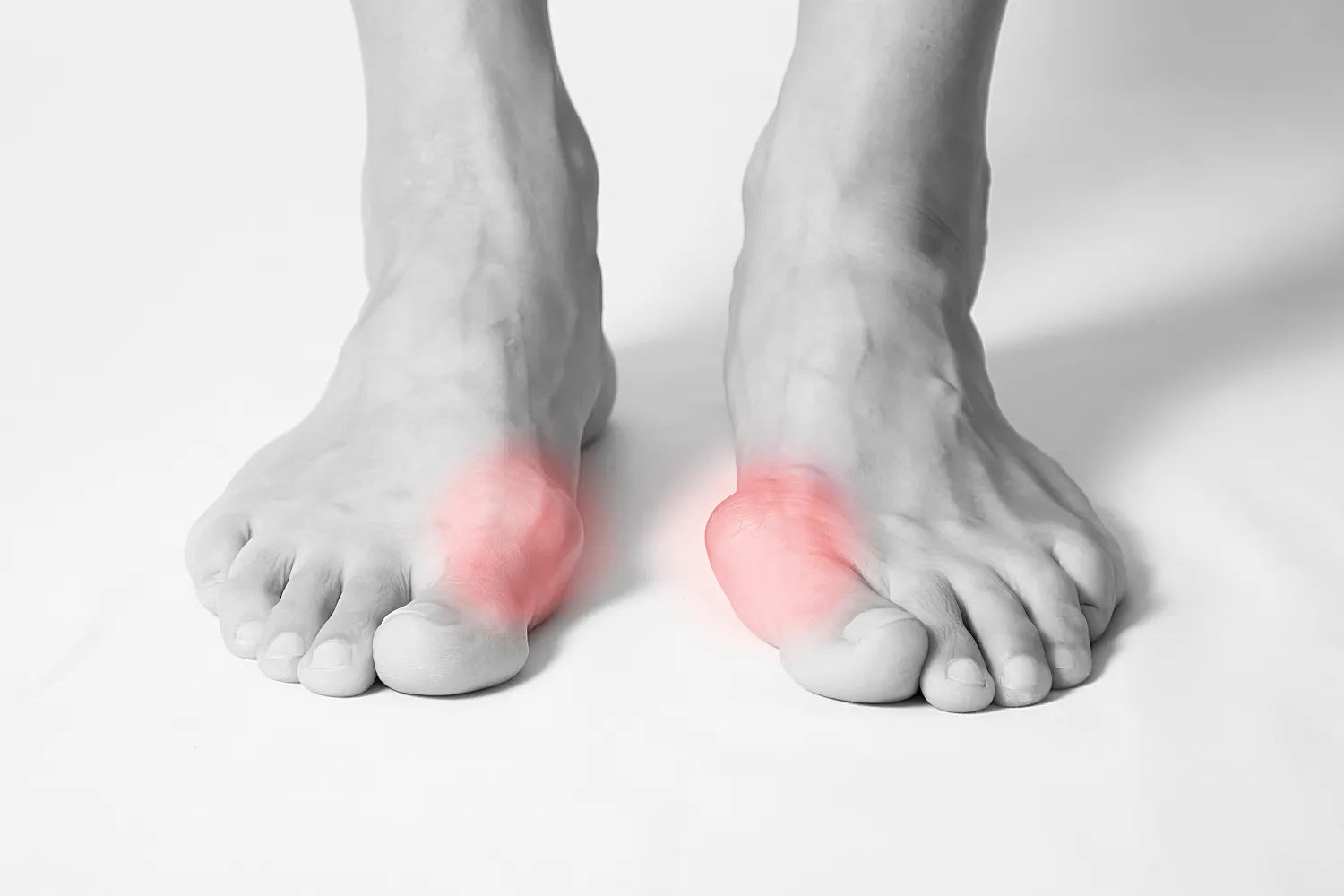Bunion Pain: Causes & How To Get Relief
If you've ever experienced a bunion, you know that a small bump can cause some trouble. While bunions can cause discomfort and affect your daily activities, understanding what they are, their causes, and how to find relief can make all the difference. Knowledge is indeed power — in this case, it's the power to prevent your bunion from worsening and reclaim the comfort you deserve.
Ready to find relief from that bony bump on your toe? Let’s discuss.
What Are Bunions?
A bunion, or hallux valgus, is a condition that develops gradually over time. It's a bony protrusion that forms on the joint at the base of your big toe. Bunions can occur when some of the bones in the front part of your foot shift out of their normal position.
This displacement causes the tip of your big toe to be pulled towards the smaller toes, forcing the joint at the base of your big toe to jut out. This protrusion can result in the big toe joint pressing against the second toe, leading to soreness and discomfort.
The skin covering the bunion may become red and tender, challenging even simple tasks like walking. You're not alone, though. In fact, it’s estimated that one-third of Americans experience bunions, making them one of the most common foot problems to experience.
However, knowing bunions are common doesn’t make them any more comfortable. Luckily, understanding the cause and solutions for bunions can help you find relief.
What Are the Different Types of Bunions?
While most people are familiar with the term “bunion,” many might not realize that there are actually different types of this condition, each with its own unique characteristics.
Hallux Valgus
This is the most common type of bunion, and the one most people typically refer to when they use the term bunion. It forms at the base of the big toe when the bone or tissue at the big toe joint moves out of place. This displacement forces the toe to bend towards the others, resulting in a noticeable bump on the foot's side.
Tailor's Bunion or Bunionette
This type of bunion forms on the outside of the foot, at the base of the little toe. It's called a Tailor's Bunion because tailors once sat cross-legged all day with the outside edge of their feet rubbing on the ground, which could lead to a bunionette.
Adolescent Bunion
This type of bunion occurs in teenagers and is usually inherited. Unlike the other types, adolescent bunions do not result from years of pressure on the foot but are instead due to hereditary factors.
Understanding the type of bunion you have can be beneficial in managing the condition and finding the most effective relief options.
What Can Cause Bunions?
Deciphering the causes of bunions can be complex as the exact cause often remains unknown. However, several contributing factors have been identified that can increase the likelihood of developing bunions.
One factor is footwear. Wearing narrow shoes or high heels that crowd your toes can create conditions conducive to the formation of bunions. Ill-fitting shoes can place excessive pressure on your toes, especially on the big toe joint, forcing it to lean towards the other toes and potentially leading to a bunion over time.
Certain foot conditions, such as hammertoes, where your toe curls or bends downward, can also contribute to the development of bunions. Rheumatoid arthritis, a condition that causes pain and inflammation in the joints, can also be a contributing factor due to the changes it can cause in the structure and functionality of the foot.
Beyond these factors, some people are more prone to developing bunions due to their inherited foot shape or structure. Genetic predisposition plays a significant role in determining your likelihood of developing this condition.
It's also worth noting that bunions are more common in women and older adults. One theory for why women develop bunions more than men is that shoes made for women are more likely to have pointed-toe boxes.
These can crowd the toes and put excessive pressure on the front of the foot, highlighting the importance of footwear when developing bunions. Age is another factor, as the likelihood of developing bunions increases as you age.
Remember, bunions don't form overnight. They develop gradually, and understanding the causes and risk factors can help you make informed decisions about your foot health, allowing you to take preventive measures or seek early treatment.
How Are Bunions Diagnosed?
If you suspect you have a bunion, it's time to pay a visit to a podiatrist. These foot specialists can accurately diagnose bunions by conducting a physical examination and asking about your symptoms. Sometimes, they may have you move your big toe back and forth to check for pain or limited movement.
An X-ray can also provide a clear picture of your foot structure. This can help the podiatrist see the extent of the misalignment in the metatarsophalangeal joint, or the base of your big toe. The X-ray results can determine the best course of action for your situation.
What Treatment Options Are Available for Bunions?
Now that you know what bunions are, let's explore some ways to manage them:
OTC Meds
Over-the-counter options offer a convenient first step in managing your foot discomfort. Pain relievers can help with particularly painful bunions, while bunion pads, usually gel or felt, provide a cushioning barrier between your bunion and your shoe.
Nonsteroidal anti-inflammatory drugs (NSAIDs) like ibuprofen and naproxen reduce the body's production of substances that cause inflammation and discomfort.
Shoe Solutions
Shoe inserts, custom orthotics, and splints work by redistributing your weight across your feet, which can help alleviate pressure on the affected joint. Custom orthotics are specially designed shoe insoles that ensure your feet are properly aligned and supported. Splints are worn at night to help hold your toes straight and reduce discomfort.
Physical Therapy
Physical therapy exercises can strengthen your feet and toe muscles, which can help maintain joint mobility and prevent stiffness. When worn at night, bunion splints can help align your big toe correctly, reducing the pressure on the metatarsophalangeal joint.
Choose Well-Fitting, Comfortable Shoes
Comfortable shoes and a wider toe box: Shoes that give your toes plenty of room are essential when managing bunions. Footwear with a wider toe box doesn't squish your toes together, giving your big toe the space to stay aligned correctly.
Warm Compresses and Ice Packs
Another beneficial approach to managing bunions is using warm compresses and ice packs. Warm compresses can help increase blood flow, relax muscles, and alleviate discomfort.
On the other hand, ice packs can help reduce swelling and numb the area, relieving discomfort. Alternating between heat and cold can be particularly beneficial. Remember, it's important to wrap the ice pack or warm compress in a towel before applying it directly to your skin to avoid any potential damage or burns.
CBD for Foot Comfort
CBD interacts with the body's endocannabinoid system (ECS), a complex cell-signaling system that influences a range of functions and processes, including pain and inflammation. CBD can help maintain your foot's health by partnering with the ECS to support relaxation and comfort. This can help keep you moving freely and comfortably, supporting the overall well-being of your feet.
Ultimately, managing bunions is all about supporting comfort and maintaining your lifestyle. Each person is unique, and so is their experience with bunions. Exploring non-surgical treatment options is all about finding the best combination of treatments for you.
With knowledge, understanding, and the right tools, you can continue to enjoy the things you love without letting bunions slow you down.
When Should You See a Doctor for Bunions?
Bunions can be a real bother, but when should you seek professional help?
If you notice a persistent or significant change in the shape of your foot or if your bunions start interfering with your daily activities, it's time to see a doctor. Experiencing consistent pain while resting is another sign that professional support is necessary. Remember, you don't have to endure discomfort — seeking help early can prevent the condition from worsening.
Sometimes, despite all your efforts, bunion surgery becomes necessary. This is often the case when the pain becomes unbearable due to severe bunions or when they significantly affect your quality of life.
Orthopedic surgeons are skilled in a variety of procedures to correct bunions. The type of surgery depends on your specific situation, including the degree of your deformity and your overall health. Bunion surgery can realign the bone, ligaments, tendons, and nerves so your big toe can return to its correct position.
What Are Tips for Preventing Bunions?
Prevention is often the best cure. Wear shoes that fit well to prevent bunions and provide plenty of space for your toes. Orthotics can also help by aligning your feet properly and redistributing your weight evenly.
Incorporating toe spacers into your routine can also be beneficial. These simple devices fit between your toes, helping to keep them aligned and to prevent your big toe from pushing against your other toes. They can be especially helpful if you notice your big toe leaning towards the others — one of the early signs of a bunion.
Maintaining foot and ankle health involves regular exercise to keep your feet and ankles strong and flexible. This helps prevent bunions and contributes to your overall health and well-being.
Remember, your feet carry you through life, so they deserve the best care possible. Taking these preventative measures can help ensure they stay comfortable and bunion-free. If you're ever in doubt, don't hesitate to contact a healthcare professional.
The Bottom Line
Understanding bunions, their causes, and treatment options is important for managing and preventing this foot condition. If you're dealing with bunion-related discomfort, don't hesitate to seek professional help from a podiatrist or foot pain specialist.
Alongside these professional bunion treatments and home care strategies, our soothing CBD topicals at Muscle MX can help support your foot comfort. Our products are carefully crafted with all-natural ingredients and are lab-tested to ensure safety and quality.
We're here to support you on your journey towards better foot health. Explore our full range of CBD products at Muscle MX and find the right fit for your needs. You can move through life easily and comfortably with the right tools and support.
Sources:
Bunions - Symptoms & causes | Mayo Clinic
Bunions: Symptoms, Causes, & Treatment | Cleveland Clinic
Hammertoes: What It Is, Causes, Relief & Treatment | Cleveland Clinic
Ice Packs vs. Warm Compresses For Pain | Johns Hopkins Medicine
Bunion Surgery | Johns Hopkins Medicine










































